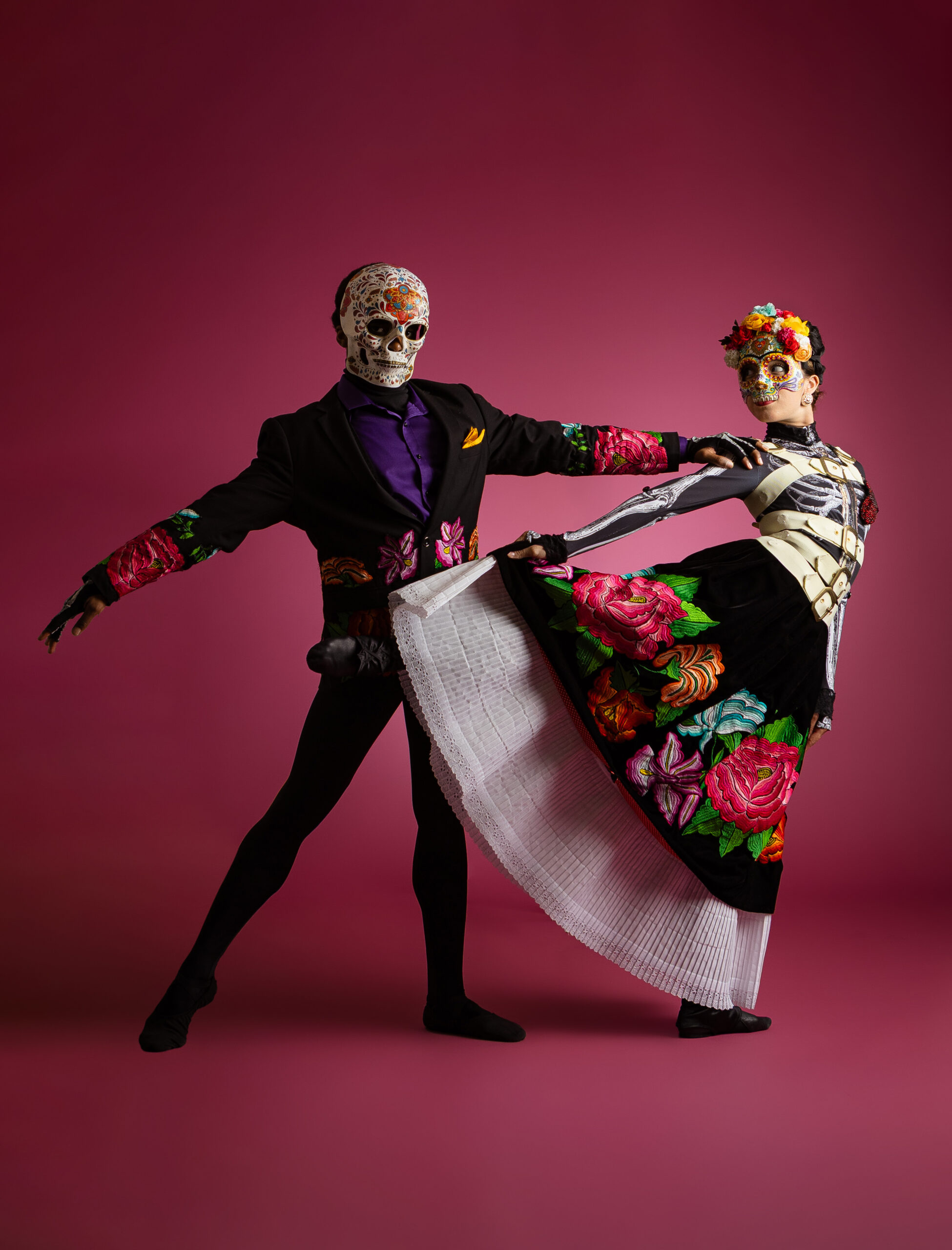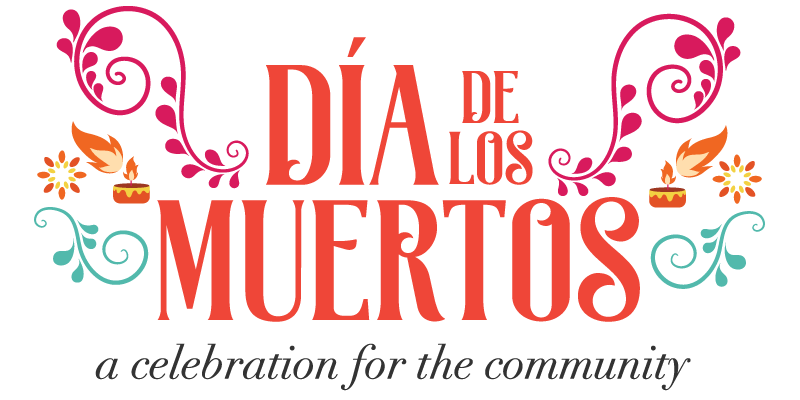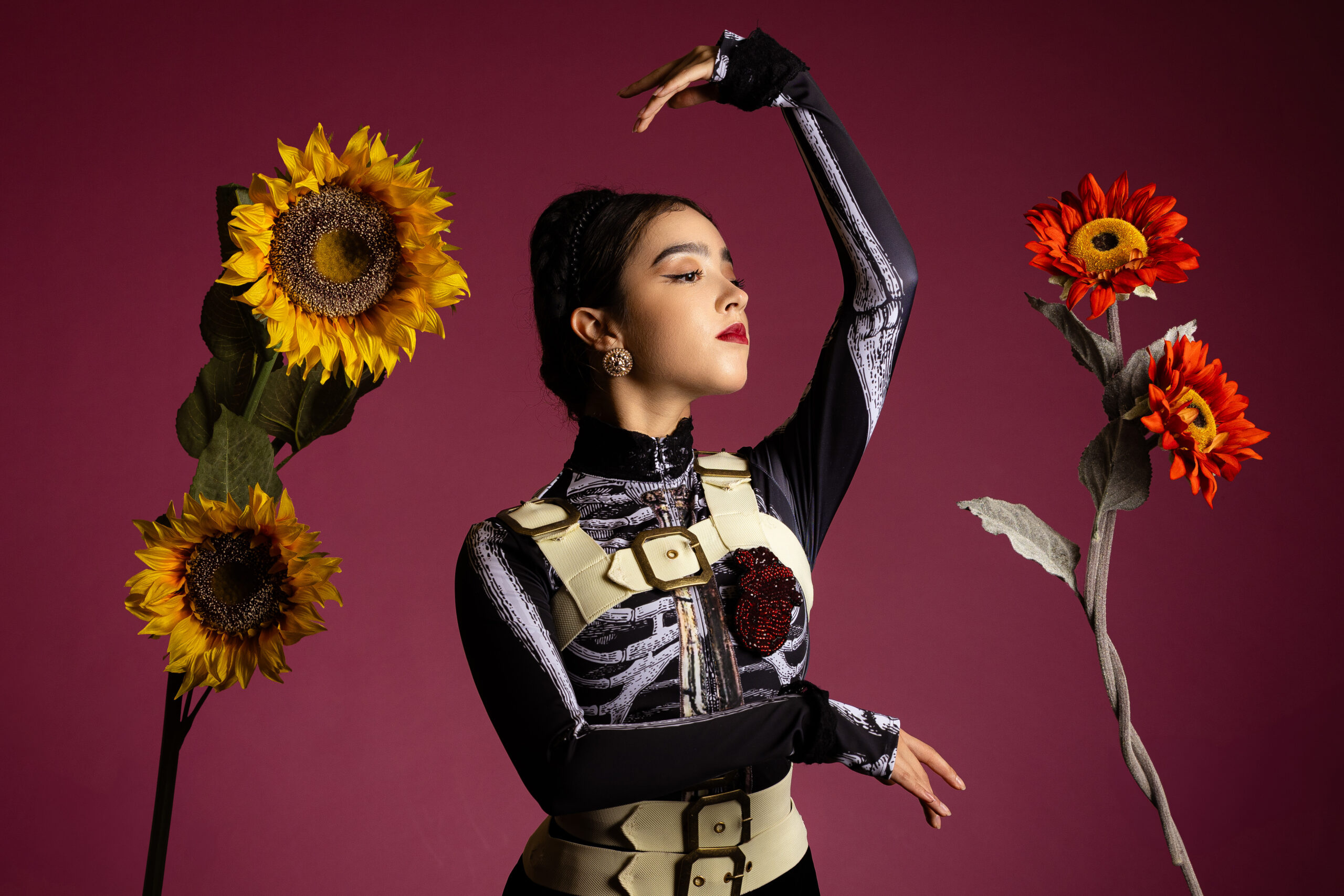THE OCTOBER 21 7PM PERFORMANCE AT THE CIVIC CENTER MUSIC HALL IS CURRENTLY SOLD OUT.
But please stay tuned! We are doing what we can to open more seats and potentially add more performances.
Thank you – we love that the Dia de los Muertos ballet is in such high demand!
¡ENTRADAS AGOTADAS! Nuestra presentación gratuita de Día de los Muertos en el Civic Center ya está oficialmente agotada.
Oklahoma City Ballet is delighted to partner with Nashville Ballet to bring Día de los Muertos to the Oklahoma City stage this season. This visually captivating production serves as both a celebration of the cultural significance of the holiday and an homage to the iconic works of Frida Kahlo and Diego Rivera.
Oklahoma City Ballet está entusiasmado en colaborar con Nashville Ballet para traer Día de los Muertos al escenario de Oklahoma City esta temporada. Esta producción visualmente cautivadora, celebra la importancia cultural de esta festividad y rinde homenaje a las obras icónicas de Frida Kahlo y Diego Rivera.
Designed with the ability to tour across diverse communities, Día de los Muertos offers a unique educational experience that immerses audiences in the vibrant traditions of Mexican culture. The performance showcases key elements such as an ofrenda (a traditional altar honoring the departed), costumes inspired by calaveras de azúcar (sugar skulls) and alebrijes (colorful folk-art sculptures), and the evocative sounds of live mariachis.
Diseñada para ser presentada en comunidades diversas, Día de los Muertos ofrece una experiencia educativa única que sumerge al público en las vibrantes tradiciones de la cultura mexicana. La presentación incluye elementos esenciales como una ofrenda (altar tradicional en honor a los difuntos), vestuarios inspirados en las calaveras de azúcar y los alebrijes (esculturas folclóricas coloridas), y los sonidos vibrantes de la música de mariachi.
Through this touring production, Oklahoma City Ballet seeks to foster greater cultural understanding and appreciation, while enriching communities with a deeper connection to the artistry and heritage of Día de los Muertos.
A través de esta producción itinerante, Oklahoma City Ballet busca fomentar una mayor comprensión y apreciación cultural, enriqueciendo a las comunidades con una conexión más profunda hacia el arte y la herencia del Día de los Muertos.
Where to see Día de los Muertos in its entirety:
October 14, 7:00 p.m.- Mustang Performing Arts Center (no tickets required; free & open seating)
October 21, 7:00 p.m.- Civic Center Music Hall (SOLD OUT)
November 2- Day of the Dead Festival at Scissortail Park
Donde ver Dia de los Muertos en su totalidad:
14 de octubre, 7:00 p.m.- Mustang Performing Arts Center (Entrada gratis y asientos sin asignar)
21 de octubre, 7:00 p.m.- Civic Center Music Hall (¡ENTRADAS AGOTADAS!)
2 de noviembre- Festival de Dia de los Muertos en Scissortail Park
Sections of Día de los Muertos will be performed during:
September 12, 7:00 p.m.- Ballet Under the Stars at Scissortail Park
September 13- Dance Day at OKC Ballet’s Brackett Dance Center
Secciones de Dia de los Muertos serán presentadas en:
12 de septiembre, 7:00 p.m.- Ballet Under the Stars en Scissortail Park
13 de septiembre - Dance Day en el Brackett Dance Center de OKC Ballet
FREE PERFORMANCE FOR SCHOOLS ON OCTOBER 21 AT CIVIC CENTER. CLICK HERE TO LEARN MORE.
PRESENTACIÓN GRATUITA PARA ESCUELAS – 21 DE OCTUBRE EN EL CIVIC CENTER. HAZ CLIC AQUÍ PARA SABER MÁS.
Frida Kahlo and Diego Rivera: The Inspiration
Frida Kahlo y Diego Rivera: La Inspiración
Maria Konrad, the creator and choreographer of this ballet, was first captivated by Diego Rivera’s mural Dream of a Sunday Afternoon in Alameda Park, which blends joy and life with underlying themes of pain. The profound experience of viewing the mural in person during a trip to Mexico City solidified its emotional impact.
Maria Konrad, creadora y coreógrafa de este ballet, quedó cautivada por el mural de Diego Rivera "Sueño de una tarde dominical en la Alameda Central", que mezcla la alegría y la vida con temas profundos de dolor. La experiencia de ver el mural en persona durante un viaje a Ciudad de México marcó profundamente su enfoque artístico.
Frida Kahlo and Diego Rivera were chosen as the central figures for this ballet due to their deep pride in their Mexican heritage and their use of cultural symbols. Both artists frequently explored themes of life, death, and the afterlife in their work—concepts closely aligned with the spirit of Día de los Muertos.
Frida Kahlo y Diego Rivera fueron seleccionados como figuras centrales de este ballet por su profundo orgullo por la herencia mexicana y su uso de símbolos culturales. Ambos exploraron con frecuencia temas de vida, muerte y el más allá en su arte—símbolos que representan el alma del Día de los Muertos.
Through their art, Frida and Diego express raw emotions such as love, sadness, and joy, which can be powerfully conveyed through ballet. Frida’s personal reflections on life and death resonate deeply with the holiday’s focus on honoring the departed. By featuring these iconic artists, the ballet not only celebrates their contributions to Mexican culture but also introduces new audiences to their powerful legacies. Their rich stories and vivid art bring a unique cultural and emotional depth to the performance.
A través de su arte, Frida y Diego expresan emociones crudas como el amor, la tristeza y la alegría, que pueden transmitirse poderosamente a través del ballet. Las reflexiones personales de Frida sobre la vida y la muerte resuenan profundamente con el enfoque del Día de los Muertos en honrar a los difuntos. Al rendir homenaje a estos artistas icónicos, el ballet no solo celebra sus contribuciones a la cultura mexicana, sino que también introduce sus poderosos legados a nuevas audiencias. Sus historias ricas y su arte vibrante aportan una profundidad cultural y emocional única a la presentación.

Education
Educación
Oklahoma City Ballet aims to bring the art of ballet to the community through accessible and culturally engaging productions such as Día de los Muertos, performed by the Studio Company. Designed to be a touring production, its length and format are adaptable to meet the needs of diverse audiences.
Oklahoma City Ballet acerca el ballet a la comunidad con producciones accesibles y culturales como Día de los Muertos, interpretada por la Studio Company. Diseñada para ser una producción itinerante, su duración y formato son adaptables para satisfacer las necesidades de audiencias diversas.
Dia de los Muertos
Día de los Muertos, or Day of the Dead, is a traditional Mexican holiday with roots in Indigenous cultures and Spanish Catholicism. Celebrated on November 1 and 2, it honors deceased loved ones through offerings, altars (ofrendas), music, food, and gatherings. Rather than mourning, it is a joyful celebration of life, memory, and cultural heritage.
Día de los Muertos, es una festividad tradicional mexicana con raíces en las culturas indígenas y el catolicismo español. Se celebra el 1 y 2 de noviembre y honra a los seres queridos fallecidos con ofrendas, altares, música, comida y reuniones. En lugar de ser un momento de duelo, es una celebración alegre de la vida, la memoria y la herencia cultural.
Ofrenda
An ofrenda is a traditional altar created during Día de los Muertos to honor deceased loved ones. It typically incorporates the four essential elements of nature:
- Earth (represented by food, especially pan de muerto- a traditional Mexican sweet bread, or a loved one’s favorite food)
- Wind (symbolized by papel picado- traditional Mexican folk art that consists of colorful paper sheets intricately cut with decorative designs)
- Fire (through candles)
- Water (offered in a glass or bowl)
These elements guide and nourish the returning spirits, creating a meaningful space for remembrance and celebration.
Una ofrenda es un altar tradicional creado durante el Día de los Muertos para honrar a los seres queridos fallecidos. Frecuentamente se incluyen los cuatro elementos esenciales de la naturaleza:
- Tierra (representada por alimentos, especialmente pan de muerto)
- Viento (simbolizado por papel picado)
- Fuego (a través de velas)
- Agua (ofrecida en un vaso o tazón)
Estos elementos guían y nutren a los espíritus que regresan, creando un espacio significativo de recuerdo y celebración.
La Calavera
La calavera, or the skull, is a prominent symbol used during Día de los Muertos to represent the cycle of life and death with humor and reverence. Often depicted as decorated sugar skulls or artistic illustrations, calaveras serve as a reminder that death is a natural part of life and are used to honor and celebrate the memory of the departed.
La calavera, es un símbolo prominente durante el Día de los Muertos que representa el ciclo de la vida y la muerte con humor y reverencia. Generalmente se representa como calaveras de azúcar decoradas o ilustraciones artísticas. Las calaveras recuerdan que la muerte es una parte natural de la vida y se utilizan para honrar y celebrar la memoria de los difuntos.




